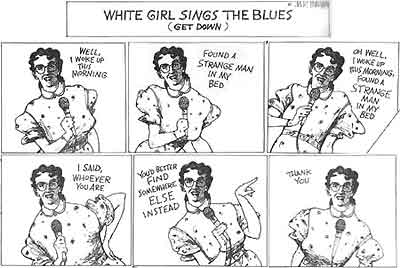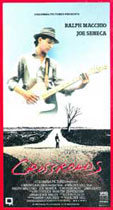| Contents > I’m a Bluesman : The role of perception in the construction of blues music by Andrew Pleffer |
| Page 1 | 2 | 3 | 4 |

Figure 3.1 “White Girl Sings the Blues”, by M.K. Brown, in National Lampoon's Truly Sick, Tasteless, and Twisted Cartoons, New York: Contemporary Books, pp.126-128.
By observing cartoons that rely on antithesis for humour, we can see how the understanding of a ‘bluesman’ goes without saying. In M.K. Brown’s cartoon (Figure 3.1), we know he is a black male because it is humorous to see a ‘white girl singing the blues’. Seizing on the gender aspect of this myth, it is worth noting that prior to the 1960s blues revival and the literature it spawned – both organised and written by middle-class white men – African-American female blues singers dominated the genre. Since then though, they have virtually disappeared and been made all but invisible. Correspondingly, the phrase ‘blueswoman’ is used so infrequently that it carries little, if any, currency. Women are seen to have so little effect on blues music that one writer claims the term ‘bluesman’ is supposedly shorthand for all blues-makers, male or female (Benston, 1975: 174). This gendering of the tradition reveals much about perceived values placed onto masculinity and femininity. In blues, the dashing young man with innate natural genius is made out to be much more intriguing than the woman with a band – after all, no one ever said that blues is a girl’s music. Thus to feminise something is to demean it and reduce it, whereas to masculinise something injects strength and status.
It is in this manner that the twentieth-century writings of Caucasian-Americans like Samuel Charters, Pete Welding and Alan Lomax have contributed to constructing our perceptions of blues music (Hamilton, 2001: 31-34). Although blues stemmed from African-American culture, attention from middle-class whites had clearly surpassed that of blacks by the 1960s (King, 2006: 236). In turn, rather than discussing the efforts of women like Bessie Smith and Ma Rainey – singers who were typically backed by male instrumentalists and had songs written for them – this new school of ‘blues scholars’ instead chose to focus their attentions elsewhere. Namely, they became transfixed with the self-accompanied, singer-songwriter, male guitarists who, as rural artists, were thought to be closest to the ‘roots’ of the blues (Siems, 1991: 141). In other words, these bluesmen somehow came to symbolise the origins of the music.
Often referred to as ‘folk’ artists, the bluesman’s individualistic mode of creativity and performance is constructed as being more ‘pure’ and ‘authentic’ than the ‘commercial’ stage shows of the blueswomen. In reality, ‘folk’ musicians and professional stage musicians were influenced by each other’s performances and recordings in an interchangeable manner that was quite complex (Carby, 1998: 474; Oliver, 1984: 49; Small, 1987: 266-267; Wald, 2004: 12-13, 282). Hence the perceived authenticity attached to bluesmen reveals less about blues music and more about those perceiving it. By widening the lens through which we perceive blues music, we can see that our bluesman may also be a woman and often subject to social and political constraints such as segregation – rather than just individualistically shunning the system and sowing his wild oats.
Much of this mythology has been perpetuated with the help of modern cinema, including movies and documentaries like Crossroads (Hill, 1986), Deep Blues (Mugge, 1991), The Search for Robert Johnson (Hunt, 1992), O Brother Where Art Thou? (Coen, 2000) and Warming by the Devil’s Fire (Burnett, 2003). Such films tell the story of the bluesman selling his soul to the Devil in exchange for “masterful musical abilities on the guitar” (Copeland & Goering, 2003: 438). Though this should be understood metaphorically rather than literally, many believe this apparently took place at the stroke of midnight at some non-descript rural crossroads (see Davis, 1995: 105-106; Evans, D. H., 1971: 22-23).

This notorious crossroads myth has been attached to blues music ever since musicians from the 1920s and 1930s began mentioning the dark Lord in their recordings. Even prior to that, blues had the stigma of being known as ‘the Devil’s music’, particularly by church-going African-Americans. In the blues revival of the late 1950s and 1960s countless white Americans and Europeans – both musicians and writers alike – embraced blues music for its perceived “real and human values” (as cited in Hamilton, 2001: 30). Ironically, it was these same people that became fascinated by blues mythology, propagating the blues-Devil association further through their Romantic responses in interviews, books, journal articles, etc. This association has since crossed over into other musical forms that stem from blues such as rock and metal, as can be seen in the film clips and artwork of bands like comic duo Tenacious D. That these ideas became attached to blues music were in no way helped by the young violent deaths of several bluesmen nor by perpetuations of the ‘crossroads story as truth’ as told by old bluesmen like Son House in the 1960s (Welding, 1966: 76).
According to Bennett Siems, “such stories draw heavily on themes and character traits which have existed for centuries in African American narrative tradition” (1991: 141). One bluesman worth mentioning here is Peetie Wheatstraw (a.k.a. William Bunch), who mythologised himself with nicknames like “The Devil’s Son-In-Law” and “High Sheriff From Hell”. This can be interpreted as a type of promotion, whereby a literal association with the Devil acts as “a protest against the drab role that the black man was supposed to fill” (Garon, 1971: 92). On the other hand, Steven C. Tracy suggests that this association is more “a conscious effort… to mock religious attitudes toward blues music” as well as “an assertion of individuality and group membership, through the creation of an identity that is both original and thoroughly grounded in African-American folklore” (1988: 56). In any case, the place of the Devil in blues music reflects a particular time and place where racism clouded creative expression. Widening our lens again, we see that a certain perception reveals a great deal more about the observer than that which is perceived.
Examining the need for such an image, it is clear that the bluesman cuts a far more heroic figure as a young itinerant musician paving his own way to hell than as that of a young man constrained by racist conventions and ideologies. Over time, the male artists whose personas have corresponded with the tragic ‘bluesman’ profile and/or have been associated with the provocative crossroads myth have since been validated by the global audience, perhaps receiving more attention than is their due.
| Page 1 | 2 | 3 | 4 |
| Contents > I’m a Bluesman : The role of perception in the construction of blues music by Andrew Pleffer |
